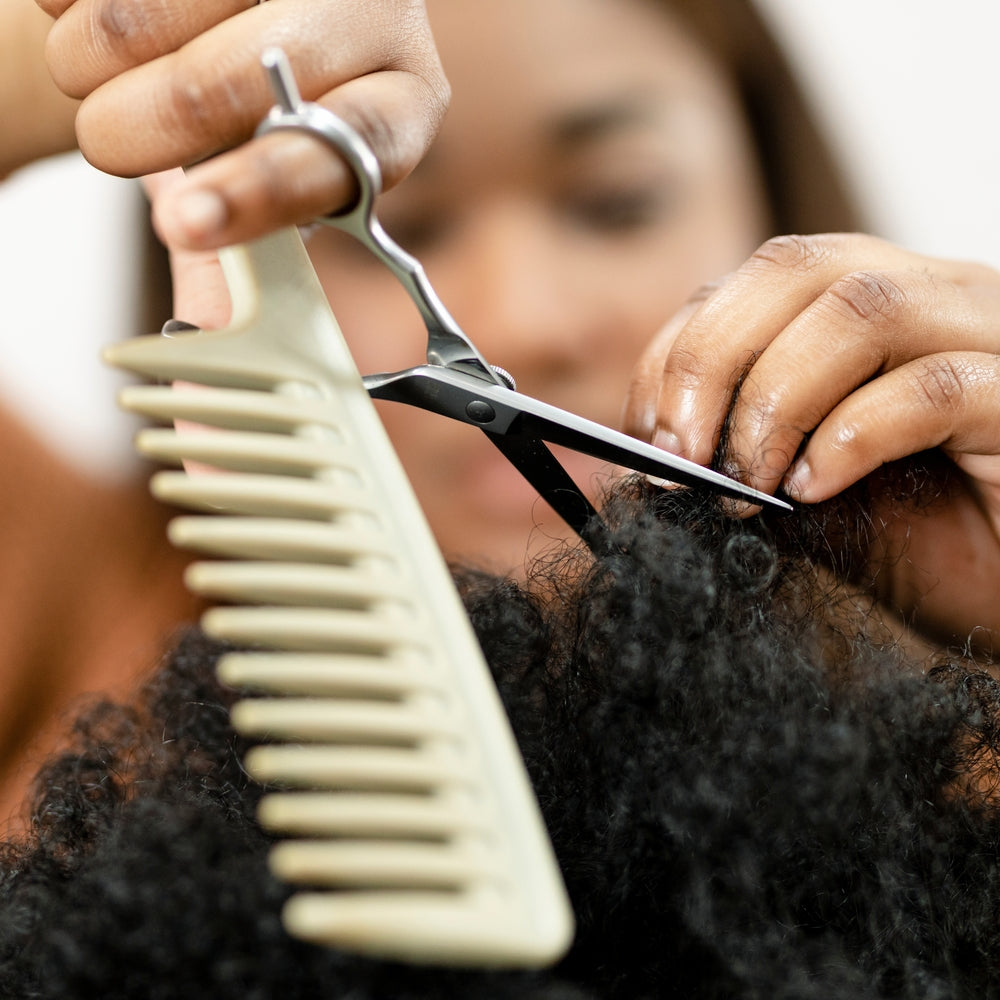

Did you know that split ends can actually travel up your hair shaft, causing more significant hair loss?
The benefits of trimming your natural hair extend far beyond just maintaining a neat appearance. In fact, those seemingly harmless split ends can transform into single-strand knots, leading to increased breakage and preventing your natural hair from reaching its full potential.
While many believe avoiding trims helps retain length, the opposite is true. How often to trim hair matters significantly - experts recommend scheduling trims every 3-4 months to maintain healthy ends and prevent damage. This is especially important because your hair ends are the most fragile part of each strand, requiring regular maintenance to stay healthy.
Ready to discover how proper trimming can transform your natural hair journey? Let's explore the essential techniques and tips for maintaining healthy, growing hair through strategic trimming.
Table of Contents
Signs Your Natural Hair Needs Trimming
Recognizing the right moment for a trim requires attention to specific signs your natural hair displays. Initially, several visual indicators signal the need for maintenance.
Visual Indicators of Damage
Your natural hair sends clear signals through visible changes. Split ends appear as frayed or forked tips at the end of your strands. Similarly, excessive frizz and flyaways, primarily at the ends, indicate damaged cuticles requiring attention. A noticeable thinning at the ends, where twists become significantly skinnier near the tips, points toward breakage patterns.
Texture Changes to Watch For
The most telling texture changes manifest in your daily hair care routine. Detangling becomes increasingly challenging, with noticeable snagging during combing sessions. Your hair's elasticity diminishes, making strands more prone to breakage. Therefore, if twists or braids unravel easily when they previously stayed sealed, your natural hair requires trimming.
Common Misconceptions About Trimming Signs
Although many believe waiting longer between trims helps retain length, this approach often backfires. The truth remains that untrimmed split ends travel up the hair shaft, leading to increased breakage closer to the scalp. Another misconception involves product effectiveness - yet no product can permanently repair split ends, although some may temporarily improve their appearance.
Regular assessment becomes crucial for natural hair, which tends to be more fragile. Watch for these specific indicators:
Constant dehydration despite moisturizing
Mushy or soggy texture when wet
Excessive single-strand knots
Persistent tangles, even with proper care
Remember that trimming serves as a preventive measure rather than just a reactive solution. Regular maintenance helps maintain definition from root to tip, supporting your overall natural hair health goals.
Post-Trim Hair Care Essentials
Maintaining your freshly trimmed hair requires a strategic approach to care and maintenance. Accordingly, establishing a proper moisture balance becomes your first priority after a trim.
Moisture Balance After Trimming
A consistent deep conditioning routine is essential for maintaining your newly trimmed ends. Experts recommend deep conditioning every two weeks to keep your natural hair properly hydrated. For optimal results, allow the deep conditioner to penetrate for 20-40 minutes. Water-based products should form the foundation of your moisturizing routine, followed by natural oils to seal in the hydration.
Protective Styling Tips
Protective styles markedly reduce daily manipulation and support your hair's health after trimming. These styles help lock in moisture and minimize breakage when properly maintained. For best results:
Keep protective styles in place for 4-5 weeks maximum
Use a silk or satin scarf at night to preserve the style
Maintain regular scalp cleansing, even with protective styles in place
Product Recommendations
Selecting the right products primarily depends on your natural hair's specific needs. First, start with a water-based leave-in conditioner, as water should be among the first ingredients listed. Natural oils like Jamaican Black Castor Oil or coconut oil work effectively for sealing in moisture.
Generally, you don't need an extensive product collection to maintain your trimmed hair. Instead, focus on these essential categories:
A quality leave-in conditioner for daily moisture
Natural oils for sealing
Deep conditioning treatments for regular maintenance
Proper product application matters equally to product selection. Hence, apply moisturizing products to damp hair and seal with oils to lock in hydration. Likewise, avoid products containing high alcohol content, which can counteract your moisturizing efforts.
Conclusion
Maintaining healthy natural hair requires understanding both science and practical care techniques. Regular trimming is a cornerstone of effective hair care, supporting your hair's natural growth cycle while preventing damage from spreading.
Your trimming schedule directly affects natural hair health and length retention. Though it might seem counterintuitive, scheduled trims every 3-4 months actually help achieve longer, healthier hair. Watching for signs like split ends, texture changes, and difficult detangling guides smart trimming decisions.
Professional expertise combined with proper post-trim care creates lasting results. Remember that healthy hair starts with prevention - addressing issues before they escalate through regular maintenance and appropriate moisture balance. Armed with knowledge about growth cycles, trimming signs, and essential care practices, you can make informed decisions about your natural hair journey.
Frequently Asked Questions
Does trimming natural hair actually promote growth?
Trimming doesn't directly cause hair to grow faster, as growth occurs from the scalp. However, regular trims help maintain natural hair health by preventing split ends from traveling up the hair shaft, which can lead to breakage. This allows you to retain more length over time.
How often should I trim my natural hair?
Experts recommend trimming natural hair every 3-4 months to maintain healthy ends and prevent damage. This schedule helps preserve the overall health of your natural hair while supporting length retention.
What are the signs that my natural hair needs a trim?
Look for visual indicators such as split ends, excessive frizz, and thinning at the ends. Other signs include difficulty detangling, decreased elasticity, and persistent single-strand knots. If you notice these issues, it's likely time for a trim.
Should I trim my natural hair wet or dry?
It's better to trim natural hair when it's dry. Wet hair can appear longer due to its stretched state, potentially leading to over-trimming. Dry hair allows a more accurate assessment of your hair's length and condition.
How can I maintain my hair's health after a trim?
Post-trim care is crucial. Establish a consistent deep conditioning routine every two weeks, use water-based moisturizers followed by natural oils to seal in hydration, and consider protective styling to minimize manipulation. Focus on maintaining moisture balance and using products tailored to your hair's needs.




